|
Car Musings: Automotive Thoughts and Opinions (2021 - Part 3)
 Time Machine: Back in 2005, James Lileks asked his readers what objects they might take with them on a trip back to 1950. Time Machine: Back in 2005, James Lileks asked his readers what objects they might take with them on a trip back to 1950.
One replied: "1950? I'd take a laptop, since you could plug it in. And I'd take a Mac, since Windows' susceptibility to viruses would probably mean my PC laptop would catch polio."
I'd choose to take a car with me. What kind? At the time, I said I'd take a early 1990s-era Nissan 300ZX and provided some reasons for my decision.
In 2008, I wrote another time travel piece and took a brand-new car back 50 years to the big, befinned and overchromed auto world of 1958. My choice surprised many readers.
Now that the 2022 models are out, I have picked a different car in which to travel to back in time to 1950. I decided to choose a sedan, rather than a crossover or SUV because people in 1950 wouldn't understand why so many people drive trucks and would ask too many questions. (Did the Russian atomic bombs wreck all the roads? Do you have to drive through the woods to avoid the polio virus?) Besides, I don't think they'd believe that the Ford F-150 pickup truck is now the best-selling vehicle in America.

I'd take a Tesla Model S Plaid back to 1950. And a 220 volt charger along with an iPhone and charger. This Tesla four-door model will do 0-60 in under 2 seconds. Quarter mile times for the Plaid are under 9 seconds with trap speeds of over 155 mph. That would absolutely astound people; most cars in 1950 took 14 to 20 seconds to reach 60 mph from a standing start. Drag racing was still in its infancy - few 1950 purpose-built dragsters - such as they were, could hit 100 mph in the quarter mile.
Some things in the car and on the phone wouldn't work, since there was no GPS or cell phone towers. But you could still use Apple CarPlay (better load it up with 1950 or earlier music - lots of Nat King Cole, Bing Crosby, Teresa Brewer, Billy Eckstein, the Dorsey Brothers and Guy Lombardo) and the availability of music you could personally choose and the number of songs which could be stored in a pocket-sized device would wow everyone in 1950. And the iPhone's basic calculator functions would impress people who live in an age of large desktop comptometers and expensive, bulky electric adding machines.
Most folks would also be impressed with detail features such as Tesla's retracting door handles, the fact that it is essentially noiseless at low speeds and the cool headlights in an era where round sealed beam headlights - one per side - were the only choice. Even though Tesla's paint quality is often considered subpar compared with its 2022 luxury competitors, it would look spectacular compared with the duller enamel finishes on a 1950 automobile.
The style of the Tesla four-door sedan would look very futuristic to everyone in 1950 - low and swoopy. And they would have trouble believing that a small (to them) battery pack could provide a range of over 300 miles between charges.
I don't think I'd tell them about the Plaid's $130,000 price tag. Even in 1950 dollars, that's a whopping $11,324, enough to buy a nice new ranch-style house in a good neighborhood. The same money could buy three posh, top-of-the line 1950 Cadillac 62 convertibles with money leftover for spotlights, curb feelers, Continental kits and Hollywood Tri-Tone tailpipe extensions. (posted 12/29/21, permalink)
Evita's Ferrari:

This photo was taken in October of 1949 at the Paris Auto show. On the right is Eva Perón of Argentina with her Superleggera (light alloy) Ferrari 166 MM Touring Barchetta. It was originally commissioned as the 1949 Paris Motor Show car and finished in Argentine racing colors (two tones of bright blue with yellow sides) as it was being prepared for the Automobile Club of Argentina. A rumor says that this Ferrari was intended as a gift to Eva Perón.
The car was used by Argentine pilot Carlos Menditeguy at the January 15th, 1950 Mar del Plata open road race, which he won. (posted 12/22/21, permalink)
Streamlined Beauty: Most so-called 'teardrop cars' don't really look much like a teardrop. This one, pictured at Mac's Motor City Garage, really does look the part.

This one-off, three-wheeled 1936 Arrowhead teardrop car was made for Arrowhead Spring Water Company of San Bernardino, California. It was commissioned because the bottler was looking for a unique and memorable marketing gimmick. The aluminum-bodied vehicle was designed by noted California stylist Wellington Everett Miller and was built by Medardo Morgagno's Advance Auto Body Works of Los Angeles.
The Arrowhead name was displayed on a vertical ridge that ran the length of the roof, illuminated by six hidden neon tubes. "At 75 inches wide and 80 inches tall, the oversized aquamarine blue goldfish was 204 inches long with a 125-inch wheelbase rolling on a 6-inch tubular steel frame. An eight-cylinder water-cooled engine mounted in the rear provided power and the car's tail opened like an alligator's mouth to provide access to the engine. … Two passengers rode comfortably in the back seat while the Arrowhead driver sat front-and-center in a leather upholstered, lounge-style chair with chromium arm rests." The engine appeared to be a flathead Ford V8.

Arrowhead's poetic advertising text described the Tear-Drop as 'The Car of 1960'. (posted 12/18/21, permalink)
There's Nothing More Tedious Than Heavy Traffic And Snow: In this early 1950s Philadelphia street scene, cars and trucks are lined up as snowflakes fall at 3:45 pm on a workday.
At left, a dark-colored Philadelphia Bulletin truck is visible, with a two-tone ... (more >>>)
Down At The Station: A late 1940s photo - posted at The Old Motor - was taken on a cold winter day at the Pennsylvania Railroad's Villanova station.
Some very nice vintage cars can be seen in the parking lot, including ... (more >>>)
In America, You're Free … to do anything you want. Even if it's tasteless. Earl Bruce of Hollywood, CA had famous California artist/pinstriper/flame-painter Von Dutch do a flame paint job on his Mercedes-Benz 300 SL gullwing coupe. Von Dutch later said, "I thought they were going to lynch me for desecrating a shrine."
Earl owned one of the early custom cars - a 1940 Ford coupe which was chopped and customized right off the showroom floor by Roy Hagy.
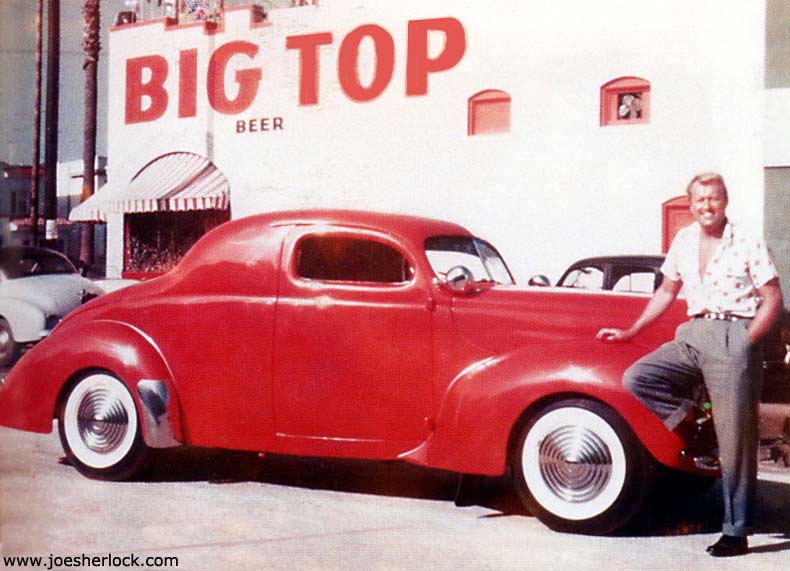
Born in 1919, Earl Bruce was an actor, bar owner and generally flamboyant character. Bruce owned a bar/jazz club, called the Big Top, located at 5336 Sunset Blvd. in Hollywood. Occasionally an actor - he appeared in the 1944 film 'Swing Hostess' - Earl Bruce was noted for his taste in fast and exotic cars and the company of ladies of the same persuasion. Bruce owned the Big Top from 1950 to 1964.
Bruce purchased the 300 SL new in 1955 and had George Barris' shop paint it in 'Sam Bronze'. It was one of the early candy jobs, and basically it was paint toner over a bronze powdered base. The paint didn't hold up, so Bruce had Von Dutch flame it to cover up the worst of the fading, which was on the rocker and sides of the car. To do this, Dutch started the flames from the rockers, and went up and over the sides of the car with them, instead of starting at the nose of the car.
Earl was a big Mercedes fan and owned 50 M-Bs over his lifetime, including six 300 SLs. (posted 12/6/21, permalink)
Book Review: 'BMW M: 50 Years of the Ultimate Driving Machines' by Tony Lewin
 BMW's Motorsport division - which produced M-series cars - came about at the urging of Bob Lutz. Maxumum Bob, as he was later known, was - at the time - BMW's Sales and Marketing Director. BMW's Motorsport division - which produced M-series cars - came about at the urging of Bob Lutz. Maxumum Bob, as he was later known, was - at the time - BMW's Sales and Marketing Director.
Founded in 1972, Motorsport at first concentrated on cars for racing; later, the 'M' designation became a marketing icon, driving retail sales to performance-oriented buyers. The BMW 2000 series, particularly the 2002tii and 2002 Turbo, was performance oriented. The compact, boxy two-door sedan's style belied the performance within. When introduced to America in the late 1960s, the 2002tii was expensive compared with other imported and American compact cars. BMW took the European version and offered only the top trim levels to Americans. In Europe, similar-looking cars with smaller 1.8-liter engines were sold at lower prices.
In 1974, I took my first ... (more >>>)
Imperial Hearse: I've never seen one in person, but National Body Co. of Knightstown, Indiana produced a 1957 Imperial hearse for the House of Diggs funeral home in Detroit Michigan.
National built at least one Imperial long-wheelbase landau end-loader in 1957. National Body Manufacturing Co. produced hundreds of Chevrolet and Pontiac-based professional vehicles. Later, the company offered a Buick-based funeral coach as well. National made only one or two hearses based on the Imperial.
House of Diggs was once called Michigan's largest funeral home. Charles C. Diggs, Sr., founded his House of Diggs Funeral Home in 1921; it serviced the black community in Detroit. In 1972, the Stinson family acquired the Diggs Funeral Home from the Diggs family. (posted 11/10/21, permalink)
Ever Buy A Car Based On An Ad? I didn't think so. Neither have I. Yes, I like car advertisements and I'll agree that a good one helps build the "brand image" or "buzz" that may pique my interest.
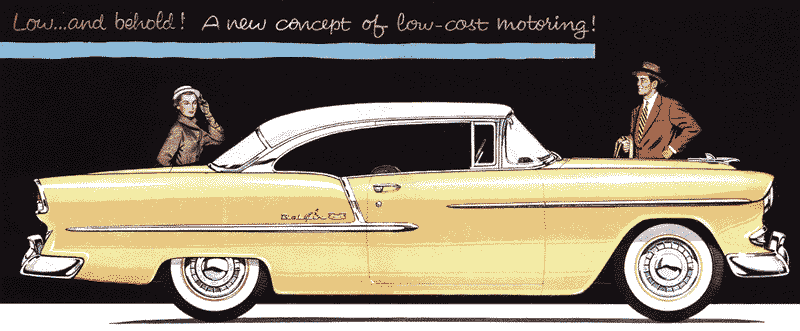
But I don't care how good the ad or television commercial is - if the car is a piece of dreck, I won't be motivated in the least to add it to my shopping list. The best ad agencies have been excellent at developing a compelling message and delivering it to a correctly-targeted, if imperfect audience.
If the product is bad, the best advertising in the world won't save it. Whoever got the 1957 Nash account, for instance, was doomed before a single tag line was set to type. The bulbous, uncompetitive car couldn't match its flashy mid-priced rivals. Modernista's Hummer ads - print and television, especially the Happy Jack spot - were entertaining, clever and engaging but couldn't save the dead-end brand. (And, who knows whether the resurrected electric Hummer will be a long-term success?)
The iconic 'Somewhere West of Laramie' didn't rescue Jordan; the advertising was more intriguing than the car.

When a manufacturer mis-targets the audience (such as the Honda Element, perceived as a college car, rather than the empty-nester/haul-gardening-stuff geezermobile it turned out to be), the ad agency can't be blamed for inappropriate ads and/or improper placement of same. Marketing people and product planners employed by automakers dictate the identity of target audiences based on research. Or the reading of chicken entrails.
 When given a decent and appealing product, ad agencies can showcase it and, occasionally, turn it into a legend. The Doyle Dane Bernbach VW Beetle campaign - exemplified by 'Think Small', 'Lemon' print ads and 'Funeral' television spot - is one example. The memorable Hal Riney campaign for the newly introduced Saturn - 'A Different Kind of Car Company' is another example. When given a decent and appealing product, ad agencies can showcase it and, occasionally, turn it into a legend. The Doyle Dane Bernbach VW Beetle campaign - exemplified by 'Think Small', 'Lemon' print ads and 'Funeral' television spot - is one example. The memorable Hal Riney campaign for the newly introduced Saturn - 'A Different Kind of Car Company' is another example.
Packard's 'Ask The Man Who Owns One' (created by the Austin Bement agency in 1901) is still another. The iconic 1975 'Ultimate Driving Machine' created by Ammirati & Puris, helped propel BMW from an also-ran brand to a serious challenger to Mercedes in the U.S. luxury car market.
 Longtime advertising sage Jeremy Bullmore met a friend for lunch outside London. When they stepped from the restaurant, the friend pointed to his shiny new Aston Martin. "Well done," Bullmore said. "I bought it because of an advertisement," the friend replied. "Good to know that what we do works," Bullmore said. "I saw the advertisement when I was 14 years-old," the friend responded. Longtime advertising sage Jeremy Bullmore met a friend for lunch outside London. When they stepped from the restaurant, the friend pointed to his shiny new Aston Martin. "Well done," Bullmore said. "I bought it because of an advertisement," the friend replied. "Good to know that what we do works," Bullmore said. "I saw the advertisement when I was 14 years-old," the friend responded.
Bullmore mused, "How do you attribute that seventy-five thousand pound purchase to an ad that ran 52 years earlier?" Even with digital ads, whose clicks are more easily measured, if his friend had clicked on the Aston Martin website, Bullmore said, "The click would get the credit for the purchase. But nobody would know and could possibly calculate what led to the click in the first place." Good point. (posted 10/27/21, permalink)
 Book Review: 'Jaguar Century: 100 Years of Automotive Excellence' by Giles Chapman Book Review: 'Jaguar Century: 100 Years of Automotive Excellence' by Giles Chapman
Jaguar is one of the world's iconic brands and is still sold worldwide. Unlike Triumph, MG and other British sports cars of yore, it still exists and produces sports cars - the Jaguar F-Type.
Since its launch as a separate marque, Jaguar has always offered sporting cars. Yes, saloons were produced for gentlemen who required extra doors or wealthy, portly lads who couldn't fit in a sports car, but from the 1930s onward, Jaguar's flagship was always a sports car. When the Jaguar XK120 burst on the automotive scene at the 1948 London Motor Show, the British sports car stunned the public. Its swoopy lines were quite a contrast with other British two-seaters - as well as older Jags - and made all of them look stodgy and ancient by comparison.
The XK120 became a big hit in the U.S., after the British government reduced ... (more >>>)
I Remember These:

And, if you grew up in the 1950s or 1960s, you'll remember them, too. (posted 10/21/21, permalink)
Book Review: 'Power Play - Tesla, Elon Musk And The Bet Of The Century' by Tim Higgins
This is the story of Tesla - the best-known electric car in the world. Tesla was founded in July 2003 by Martin Eberhard and Marc Tarpenning. Elon Musk didn't come into the picture until February 2004 when he became an investor. He has served as CEO since 2008. Eberhard was forced out in 2008. In 2009, Eberhard sued Elon Musk for libel, slander, and breach of contract. Tarpenning also left in 2008.
This book details the ongoing soap-opera known as Tesla. There are many sordid stories told as the company bounced from crisis to crisis. Tesla has many critics but it must be acknowledged that of all the automobile start-ups since World War II, Tesla and Kaiser-Fraser Motors are the only ones which actually manufactured and delivered vehicles in volume to customers. And Tesla only produces all-electric vehicles - no hybrids, no internal combustion options.
Tesla claimed it delivered 241,300 vehicles worldwide during the third quarter of 2021 - an impressive number. In the U.S. market ... (more >>>)
Happy Car: This period picture of 1939 Willys Overland makes me smile. It seems like such a happy car.
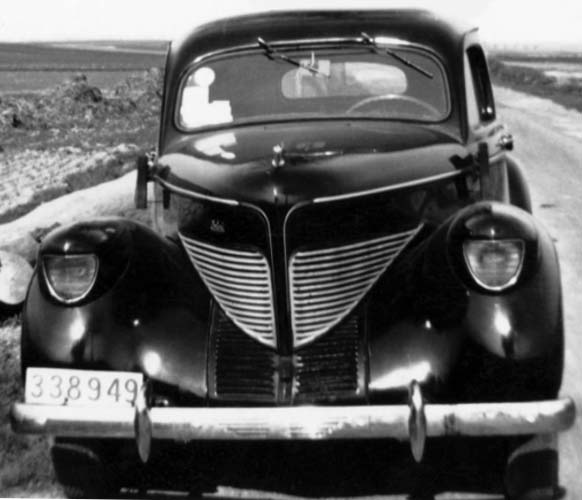
The Willys was restyled for 1939 (with a sharknose-type prow with the undercut hood and headlight pods mounted on the front fenders) and given the designation 'Overland'. It was a little car, riding on a 102-inch wheelbase and weighing under 2,200 pounds. The 134 cubic-inch flathead inline-four engine now made 62 horsepower - up from 48 hp in 1938. Willys-Overland chief engineer Barney Roos and his team updated the engine with aluminum pistons, shell bearings, and full-pressure lubrication. It was fitted with Bendix hydraulic brakes all around.
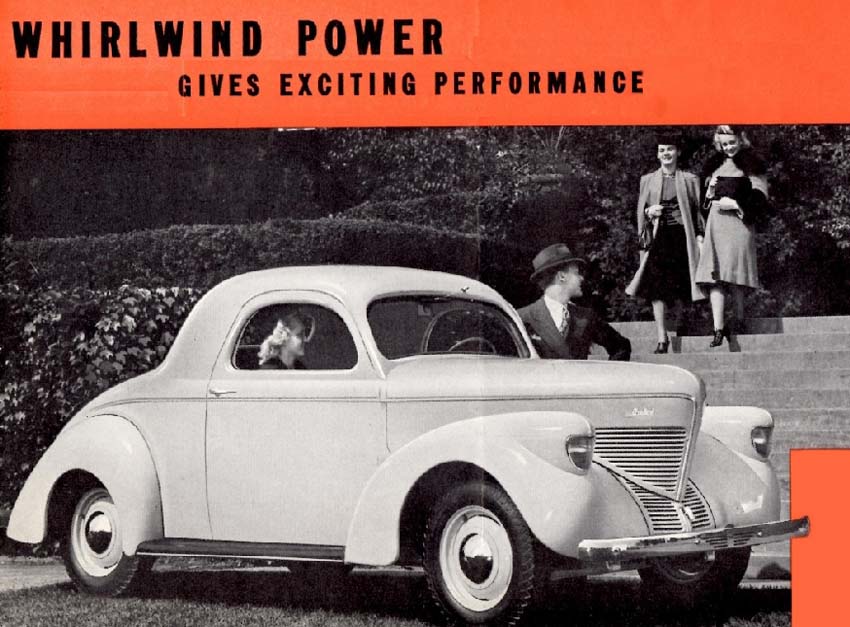
The two-passenger Deluxe coupe was priced at only $646. Willys sold only 15,214 cars in 1939. I'm surprised such a happy little car didn't find more buyers. (posted 10/15/21, permalink)
Step-Down Design - Hudson's Last Triumph: For the 1948 model year, independent automaker Hudson - a company founded in 1909 - introduced cars with the 'step-down' look. Floorboards were lower than the doorsills and you stepped down to enter the car. This change produced a low and sleek car without sacrificing headroom. The low center of gravity and a stiff unibody structure made the step-down Hudson the best-handling American car of its time. The heft and a relatively long wheelbase insured a comfortable ride.

Mechanix Illustrated's Tom McCahill wrote, "Hudsons are ripping the feathers out of the other brands on one simple, but oh so vital, point. They are America's finest road cars from the very important standpoint of roadability, cornering, and steering. … To stay with the Hudsons on a race course, these other cars must literally pull themselves apart in the corners, while the Hudsons sail around with effortless ease."
The new Hudson was priced ... (more >>>)
Far-East Crosley: Robert D. Cunningham posted an interesting story in The Old Motor about an early post-war Datsun that looked remarkably like a post-war Crosley small car.
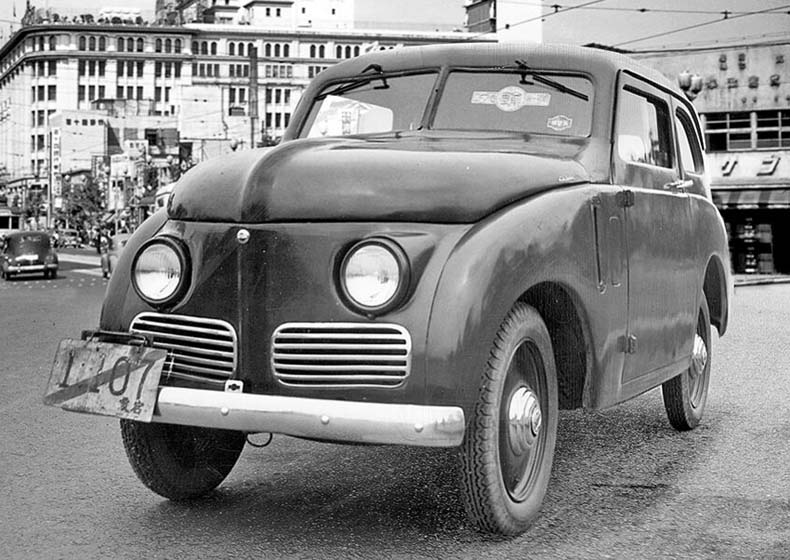
"To the casual observer, the Datsun D.B. was just a Crosley sedan with larger wheels. Its body shape and styling were nearly identical, right down to the two-piece grille design and fresh-air vents on the front fenders. All it lacked was a signed licensing agreement from Crosley Motors. … The D.B. was slightly larger than the Crosley CC but significantly less powerful than Crosley's 750 cc, 26.5 horsepower engine." (posted 10/11/21, permalink)
Book Review: 'American Station Wagons - The Golden Era 1950-1975' by Norm Mort
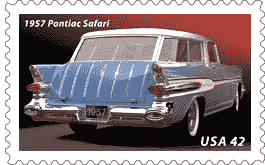 Station wagons have evolved from their early use as specialized vehicles to carry people and luggage to and from train stations to use as a family vehicle. The first station wagons were built in around 1910, by independent manufacturers producing custom wood bodies for Ford Model Ts. Station wagons have evolved from their early use as specialized vehicles to carry people and luggage to and from train stations to use as a family vehicle. The first station wagons were built in around 1910, by independent manufacturers producing custom wood bodies for Ford Model Ts.
Eventually, car manufacturers began producing their own station wagon designs beginning in the mid-1920s. The first postwar mass-produced steel-bodied station wagon was the 1946 Willys Station Wagon. By 1951, most station wagons were being produced with all-steel bodies although some models had wood trim - either genuine or fake. Wagons followed the design trends as their sedan brethren - fins, hardtop styling, compact versions, etc.
In the U.S., the heyday of station wagons was in the late 1950s to early 1960s. In 1950, station wagons accounted for only 2.2% of overall Ford sales. By 1955, the share had grown to 14.4%. By 1960, 17.1% of all Fords produced were wagons. By 1965, the figure dropped to 11.6%, falling to 7.3% by 1970. Author Norm Mort provides similar figures for the industry: "In 1951, American station wagon sales totaled 174,500 - 3.3% of the car market in the United State; by 1960, this figure had leapt to 932,000 units, or 15.4% of the American car market."
In the 1970s ... (more >>>)
Nice Luggage:
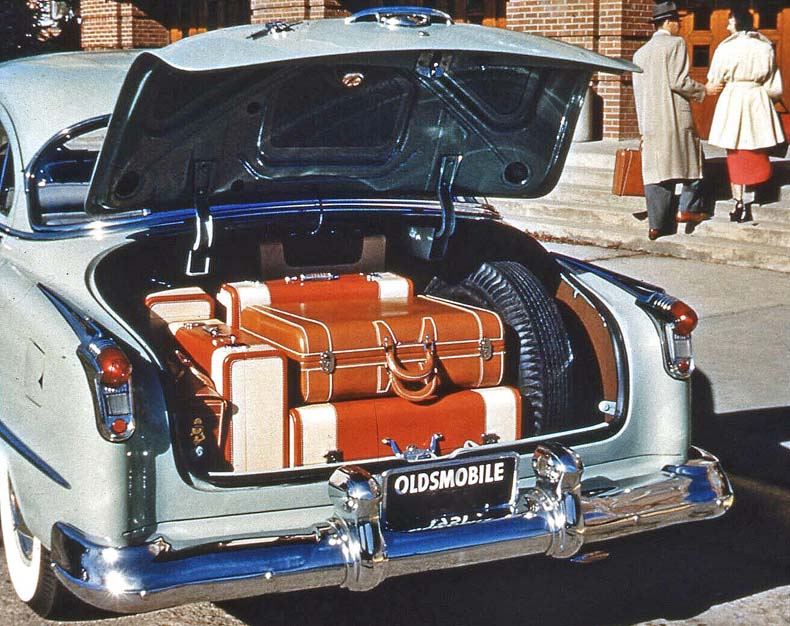
In the 1950s, most leather luggage was pretty classy and made in the USA, as seen in the trunk of this 1951 Oldsmobile Rocket 88. (posted 10/5/21, permalink)
Never Saw One Of These Before: In my youth, I saw many ice cream trucks patrolling the streets of my neighborhood. All the Good Humor ones were based on Ford or Chevy trucks. Mister Softee and some independents used small step vans.

This 1951 Crosley is one of several surviving Good Humor trucks based on the miniature Crosley automobile.
Powell J. Crosley, Jr. was an entrepreneur, inventor as well as a radio and refrigerator magnate in the 1920s and '30s. He also operated radio stations. But he dreamed of becoming an automobile manufacturer.
Crosley made small, low-priced automobiles from 1939 to 1952, with an interruption during World War II when it produced field kitchens, quarter-ton trailers and other military items. Crosley station wagons were the most popular model, but the manufacturer also offered sedans, pickups, convertibles, a sports car - the Hotshot, and even a tiny jeep-like vehicle. Crosleys were little (145 inches long) about 15 inches sorter than a VW Beetle.
The company's biggest sales year was in car-starved 1948 when 28,734 Crosleys were sold. By 1951 sales had dropped to 1,94 vehicles. They were powered by a 26.5 horsepower engine and weighed between 1,200 and 1350 pounds, depending on the model.
Famous Crosley owners included actor Humphrey Bogart, bandleader Tommy Dorsey, President Dwight D. Eisenhower, television personality Art Linkletter and actress Gloria Swanson. (posted 9/27/21, permalink)
Book Review: 'Lincoln Design Heritage: Zephyr to LS (1936-2000)' by Jim & Cheryl Farrell
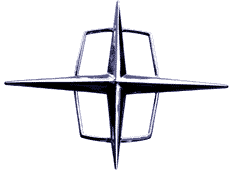 This large-format (approx. 10" x 13") heavy (over six pounds) hardbound book offers coffee table appeal along with a plethora of photographs, artwork and images (1,600 photos total), over 230 bios of designers and clay modelers and a comprehensive history of Lincoln's most important decades. It is a 475-page story plus bibliography and index - over 200,000 words. This limited-edition book is a labor of love by the Farrells, who traveled to Detroit/Dearborn on numerous occasions to scour the Ford Archives, the Henry Ford Museum historical records, as well those at the National Automotive History Collection at the Detroit Library. They also did research at the Art Center College in California, the Collier Automotive Museum collection in Florida as well as other resource sites. The Farrells interviewed hundreds of former Ford employees in order to factually document events chronicled in their book. This large-format (approx. 10" x 13") heavy (over six pounds) hardbound book offers coffee table appeal along with a plethora of photographs, artwork and images (1,600 photos total), over 230 bios of designers and clay modelers and a comprehensive history of Lincoln's most important decades. It is a 475-page story plus bibliography and index - over 200,000 words. This limited-edition book is a labor of love by the Farrells, who traveled to Detroit/Dearborn on numerous occasions to scour the Ford Archives, the Henry Ford Museum historical records, as well those at the National Automotive History Collection at the Detroit Library. They also did research at the Art Center College in California, the Collier Automotive Museum collection in Florida as well as other resource sites. The Farrells interviewed hundreds of former Ford employees in order to factually document events chronicled in their book.
In 1999, Jim & Cheryl Farrell wrote and published the highly-acclaimed 'Ford Design Department Concept & Show Cars 1932-1961' (399 pages, over 900 photos, published in 1999) which now fetches $2-300 on the used book market. In that book, every chapter was about a different car; therefore, each chapter stood alone and the book could be read out of order without losing continuity.
'Lincoln Design Heritage' flows chronologically, beginning with the pre-Zephyr John Tjaarda experimental ... (more >>>)
Artistry In Wood:
This is the wooden buck used to make the very first Corvettes. (posted 9/23/21, permalink)
Taxi! The Old Motor posted a 1945 stock footage film that has been colorized, restored, and sound added. It is filled with passenger cars, taxis, trucks, and pedestrians. The bulk of the movie is reported to have been shot on 8th Avenue. Running time is just under five minutes. I spotted at least five 1939 Plymouth taxicabs in the film.

The summer streets were full of taxis in those days, most were either Checkers or Plymouths of various vintages (1938-41). (posted 9/17/21, permalink)
Keep That Motor Humming: A 1940s-era ad in the Saturday Evening Post, promotes Whiz Motor Rythm, to help restore lost power and stretch gasoline rations.
The Whiz line of products was made by R. M. Hollingshead Corporation. The company was founded in 1888 by Richard Milton Hollingshead. Richard was a born entrepreneur, staring the firm in Camden, New Jersey when he was only 20 years-old. Eventually, R. M. Hollingshead became one of Camden's largest employers, offering Whiz lubricants, auto grease, oil, anti-freeze, metal polish, wax, auto-top dressing, tire coating, brake fluid, paint remover, soap, antiseptics, and insecticides. Products/brands included Krystal Soiloff, Whiz Anti-Freeze, Whiz Body Polish, Whiz Cup Grease, Whiz Japan Iron Enamel, Whiz Loosen-All Lubricant, Whiz Metal Polish, Whiz Motor Rythm, Whiz Non-Fluid Oil, Whiz Transmission Grease, Whiz Venus Polish and Whizoil Soap.
Mr. Hollingshead of Riverton, N.J. died on May 16, 1945 in Pennsylvania Hospital after a brief illness. He was 77 years old and was a yachting enthusiast. The company was acquired by the Dayco Corporation in 1971, and again by the Classic Chemical Company, division of Classic Products Ltd. in 1974. The company dissolved in 1981 after Classic Chemical shut down its Camden plant. (posted 9/15/21, permalink)
Impress The Hell Out Of Your Neighbors: Some of the wild vehicles featured in the 2015 film 'Mad Max: Fury Road' will hit the auction block this month.

One of the vehicles is Gigahorse. "Atop its custom-raked chassis sits two 1959 Cadillac Coupe de Villes, towering fins and all, and under its hood a pair of supercharged 502-cu.in. Chevrolet big-block V-8s generated an estimated 1,200 horsepower to turn the dually 70-inch tractor tires. Though Gibson envisioned the Gigahorse, it fell to concept artist Peter Pound to flesh it out and Anthony Natoli to make it all work. In total, it weighs about 23,000 pounds and stands about 13 feet tall."
Imagine Gigahorse parked in your dirveway. (posted 9/13/21, permalink)
Fairmount Park Auto Races: The Old Motor has posted photos from the 1911 Fairmount Park race in Philadelphia, PA. I never knew such races existed.
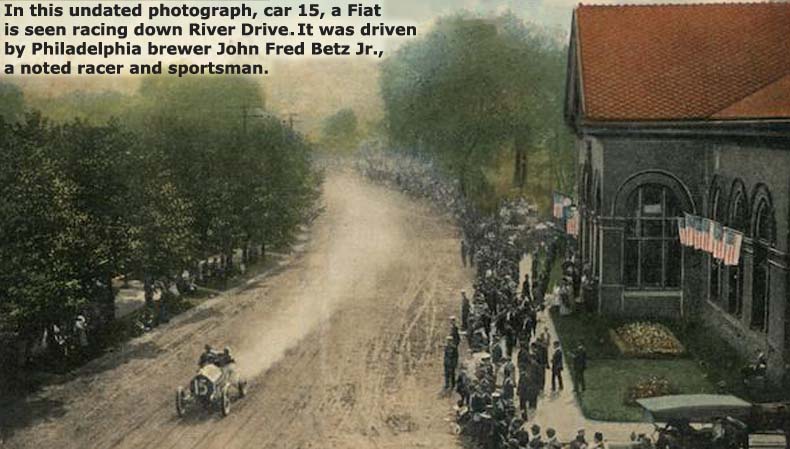
Fairmount Park, Philadelphia's first park, is the largest municipal park in Philadelphia, Pennsylvania and the historic name for a group of parks located throughout the city. Fairmount Park consists of two park sections named East Park and West Park, divided by the Schuylkill River, with the two sections together totaling 2,052 acres. The park was the site of ... (more >>>)
Quick, Before You Need Coupons:
At 7:00 am on June 21, 1942, the day before stricter gas rationing was enforced, cars were pouring into this gas station on upper Wisconsin Avenue in Washington, DC. A dark-colored 1941 or '42 Packard Clipper waits patiently in line. (posted 9/7/21, permalink)
Odd Movie Limo: The 1933 headline read: 'Movie Mechanics Rebuild 13 Year-old Car Into Ultra-Modern Limousine':
The caption/story reported, "Hollywood was set agog recently when an automobile of startling, ultramodernistic design appeared on the streets. The creation was the work of Hollywood carriage-makers, who built it from an old bus that had been prowling the streets since 1920. The 'chariot on wheels', as the bus is called, is to be used in a movie telling a story of events in a mythical kingdom. Though the car seems to represent a fabulous cost, in reality it cost less than the price of two small cars."
This second photo - from Trend Books 1953 softcover publication, 'Dream Cars' by Fred Horsley - describes the car as having a "battering ram" on the front which doubles as "extra throne space in front" for a king. I saw a color image of this car somewhere and - at the time - it was painted pink. (posted 9/1/21, permalink)
Earlier Car Musings can be found here.
Other Pages Of Interest
| blog: 'The View Through The Windshield' |
| greatest hits: index of essays & articles | blog archives | '39 Plymouth |
| model train layout | about me | about the blog | e-mail |
copyright 2021 - Joseph M. Sherlock - All applicable rights reserved
Disclaimer
The facts presented on this website are based on my best guesses and my substantially faulty geezer memory. The opinions expressed herein are strictly those of the author and are protected by the U.S. Constitution. Probably.
If I have slandered any brands of automobiles, either expressly or inadvertently, they're most likely crap cars and deserve it. Automobile manufacturers should be aware that they always have the option of trying to change my mind by providing me with vehicles to test drive. I'll dutifully report my road test impressions on this car blog.
If I have slandered any people or corporations, either expressly or inadvertently, they should buy me strong drinks (and an expensive meal) and try to prove to me that they're not the jerks I've portrayed them to be. If you're buying, I'm willing to listen.
|